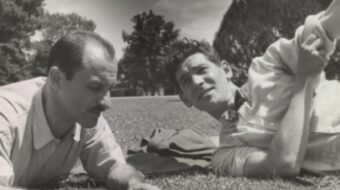
BURBANK, Calif. – Mark St. Germain’s Scott and Hem imagines a 1937 F. Scott Fitzgerald (Thomas Owen) and Ernest Hemingway (Ty Mayberry) tête-à-tête, when the latter shows up uninvited and unannounced at the former’s unit in Hollywood’s Garden of Allah complex. Sparks fly as the renowned authors revisit their literary rivalry and friendship during those fabled “Lost Generation” days at Gertrude Stein’s Parisian salon, the French Riviera, etc. Adding to the combustible mix is liquor – Hem swills bottle after bottle (and pops a pill or two), while Scott tries to dry out – and the sexually alluring Eve Montaigne (Jackie Seiden), is Fitzgerald’s swanky minder, cracking the whip so The Great Gatsby scribe stays sober and completes rewrites for Louis B. Mayer.
Hemingway is in Hollywood attending screenings of Joris Ivens’ documentary The Spanish Earth to raise funds for the beleaguered Loyalist side during the Spanish Civil War, pitting Spain’s Republican forces against Generalissimo Franco’s fascists, backed by Hitler and Mussolini. The Hollywood Left backed the Republic and The Spanish Earth, which Hemingway co-wrote and spoke the English language narration for. Of course, in what is arguably his finest moment, Hemingway risked his neck by going to war-torn Spain, out of which emergedwhat may be his finest novel, the anti-fascist classic For Whom the Bell Tolls.
(Fun Fact #1: Ironically, the director of the 1943 screen adaptation of For Whom the Bell Tolls, which co-starred Gary Cooper and Ingrid Bergman, was actually an extreme rightwinger, Sam Wood, who is depicted by John Getz in the new biopic Trumbo as the president of the redbaiting Motion Picture Alliance for the Preservation of American Ideals.)
As the above reference to The Spanish Earth suggests, Scott and Hem seems to mix facts with conjecture conjured by the playwright. In a recent L.A. Times cover story Steve Zeitchik discussed “a new cinematic breed…called the impressionistic biopic.” As opposed to documentaries and docudramas that seek to accurately, faithfully recreate and represent the life stories of historical personages, the “impressionistic biopic” uses much poetic license, including invented scenes and dialogues, to convey the essence of actual persons and events, instead of relying solely on mere facts. Scott and Hem suggests a theatrical version of this – call it an “impressionistic bio-play.”
As Hemingway and Fitzgerald alternately reminisce about the good old days, compete and clash, readers of The Snows of Kilimanjaro and The Great Gatsby may be absorbed and fascinated by these behind-the- scenes portrayals. There is much dialogue about the art and craft of writing in this verbose play; some may find it sheds light on the literary creative process.
But purists may be turned off by the not so tender night of these not so beautiful and god-damned authors. The central role alcohol plays in their lives is troubling, as is their rampant egomania. For those aspiring artistes who have never hit the big time, you’d think that connecting with a wide audience, attaining acclaim, not to mention fame and fortune, would bring some measure of happiness.
Of course, this doesn’t take into account the authors’ inner demons – Hemingway laments having one of those mothers from hell, who dressed him in girls’ clothing, and a father who shot himself (foreshadowing Ernest’s own tragic denouement). He is literally far too self-obsessed with the importance of being Ernest. But Fitzgerald recounts a happy childhood, so troubled parenting doesn’t explain this Jazz Age genius’ subsequent bedevilment. To be sure, the effect that so-called “bitch goddess” of fame causes must also be part of the psychic equation – but this is something those who haven’t experienced will find it hard to fully comprehend.
But does it all ring true?
Some of Scott and Hem’s “facts” fail to ring true: Their purported self-regard as the only great writers of their era is preposterously absurd – not only do they diss William Faulkner, but they don’t even mention Steinbeck, et al. On the one hand, we’re told that in 1936 only about 40 copies of Fitzgerald’s novels sold in the entire USA. But later he claims to be the highest paid short story writer in America. These two points do not compute. Nor does the notion that Scott is broke, when it’s subsequently stated that he earns $1,000 per week as an MGM contract screenwriter. One could still live on that salary in 2015, but almost 80 years ago, during the throes of the Great Depression, that was a king’s ransom.
To be fair, the writer is paying for the mental asylum where his wife Zelda is being cared for. Zelda Fitzgerald is a pall over the play, an offstage presence felt deeply by Scott and a source of friction between him and Ernest. So is their possible latent homoeroticism that is hinted at from time to time during the course of this one-act, 75-minute play.
Fitzgerald is supposedly shilling for and selling his soul to Hollywood, as if screenwriting is a disgraceful calling, compared to being a novelist. Yet what was the subject matter of Scott’s final novel? The Last Tycoon, of course, is about Hollywood and the class struggle there, with unions versus moguls, etc.
It’s interesting to note that in addition to being portrayed in a number of movies – including in HBO’s 2012 Hemingway & Gellhorn, with Clive Owen playing Ernest – the two authors’ fiction has often been adapted for the screen, including a Fitzgerald short story in 2008’s The Curious Case of Benjamin Button and Baz Luhrmann’s big budget 2013 Gatsby. And in Barbara Kopple’s 2013 doc Running From Crazy,Mariel Hemingway candidly explores her family’s troubled history of suicide and alcoholism.
As sexy as the aforementioned character called Eve Montaigne is, there’s more to her than meets the eye, as would-be “he-me” Hemingway tries pursuing her. Which of the authors, if any, will succeed in romancing her? “Eve Montaigne” appears to be a pseudonym for the young woman who actually was Scott’s secretary and companion of sorts toward the end of his life. Neve Campbell portrayed his real-life personal assistant Frances Kroll in the 2002 TV movie Fitzgerald, starring Jeremy Irons as Scott and Sissy Spacek as Zelda.
(“Fun” Fact #2: Frances Kroll just died in June 2015 at the age of 99. Her book, Against the Current: As I Remember F. Scott Fitzgerald, was the basis for the Fitzgerald biopic.)
Although Scott and Hem is sometimes overwrought and excessively talkative, its actors are ably directed by Dmitri Toscas. Designer Francois-Pierre Couture’s realistic set captures the unrealistic ambiance of the Garden of Allah, where many Tinseltown talents holed up. Jackie Seiden excels as the beauty who has a brain, as well as a body and pretty face – plus something up her sleeve. The bearded Ty Mayberry’s visage actually resembles the young Hemingway. Thomas Owen is touching as the genius desperately trying not to go off the rails (although I believe he’s way too tall for Fitzgerald).
This drama is probably for theatergoers who are interested in these authors, in literature and writing. It may not be everyone’s cup of theatrical tea, although for the most part I enjoyed seeing these literary lions brought back, if briefly, to life.
Scott and Hem is being performed Weds., Thurs., Fri. and Sat. at 8:00 pm and Sun. at 4:00 pm through Nov. 15 at the Falcon Theatre, 4252 Riverside Dr., Burbank 91505. For more info: (818)955-8101; www.FalconTheatre.com.










